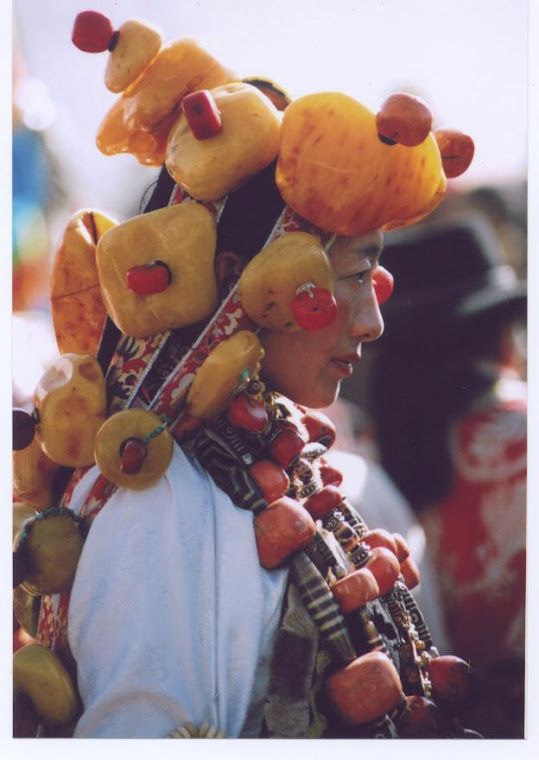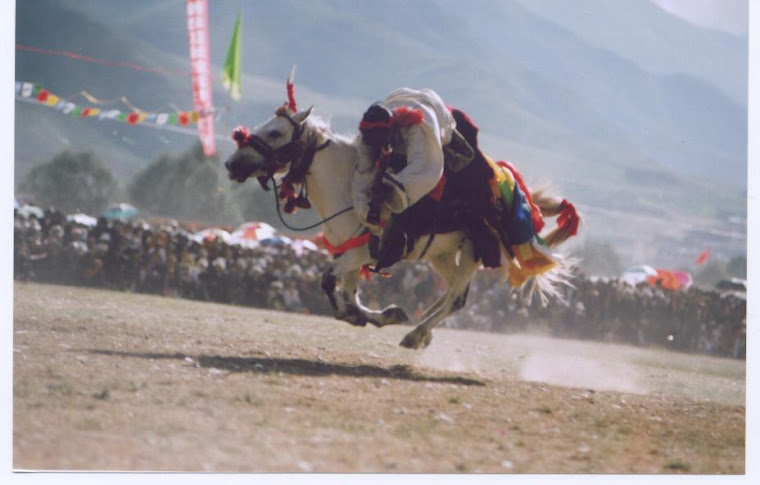2008/10/22
Tibetan Buddhism
Tibetan BuddhismTradition has it that Tibet is the land of Avalokiteshvara, the Bodhisattva of compassion, and the Tibetan people are his descendants. They trace their ancestry to the copulation of an ape, an emanation of Avalokiteshvara, and an ogress, an emanation of the goddess Tara, whose progeny gave birth to the Tibetan people in the Yarlung valley.
The early Tibetan nation was without a ruler until 127 B.C.E., when according to legend an Indian king named Rupati fled over the Himalayas after his defeat in Mahabharata war and reached the Yarlung valley. There, he was enthroned as their king by twelve wise Bön priests, who, believing that he had descended from heaven gave him the name Nyatri Tsenpo. From this time, the Tibetans evolved a distinct but simple civilization founded on the idea of the inter. dependence of man and nature. In the pre-Buddhist period Tibet's indigenous religion and culture was Bon, a fragment of which, though radically transformed through its contact with Buddhism, is still preserved among Tibetan communities in exile.
Buddhism became Tibet's state religion only later. Introduced for the first time in 173 C.E., during the reign of King Lha Thothori Nyantsen, it was gradually assimilated, disseminated and finally integrated into the Tibetan way of life due initially to the efforts of the religious kings. King Song Tsen Gampo took control of the kingdom at the age of thirteen and built Rasa Trulnang Tsuglag Kbang and Ramoche Tsuglag Khang two temples in Lhasa. He sent his minister Thonmi Sambhota to India to learn Sanskrit and writing, and as a result a Tibetan script was then modelled one of those current in India. He invited Acharya Kumara and Brahmin Shankara from India and the Nepalese Acharya Shilmanju, who began the propagation and translation of the Buddha's teachings. Although there was neither conspicuous nor extensive study of Buddhist doctrine, the king himself gave instructions to many fortunate people, mostly concerning the teachings of the Arya Avalokiteshvara.
During the reign of King Trisong Deutsen, Buddhism was spread with great zeal after he had invited the Abbot Shantarakshita and Acharya Padmasambhava to Tibet. The task of translating Buddha's teachings was carried out with great vigour and enthusiasm. It is said that altogether one hundred and eight Indian scholars were engaged with Tibetan translators in the work of translating Buddhist literature into Tibetan. They also took part in establishing monasteries.
After three generations, the religious king Tri Ralpachen issued a decree that every monk should be supported by seven households. At the same time thousands of temples were constructed. He also invited many more Indian masters such as the Acharyas Jinamitra, Surendrabodhi and Danashila, who with the Tibetan translators Yeshede and others revised and standardised the earlier translations according to a revised terminology. In this way the Buddha's teachings were increasingly being propagated throughout Tibet. Unfortunately, this golden period known as the era of the Tibet's Religious Kings soon came to an end. Ralpachen's successor, King Lang Darma, did not support the Buddha's teaching. Monasteries were emptied and the monks made to disrobe, often being recruited into the army. As the Tibetan empire disintegrated into small principalities, Tibetan Buddhist culture entered a dark period.
However, at that time Mar Shakya Yeshi, Yogejung and Tsang Rabsel, holders of the monastic lineage of the great Abbot Shantarakshita managed to escape to the Domey (north-eastern) region of Tibet, where with the assistance of two Chinese monks they gave full ordination to Lachen Gongpa Rabsel, which marked the revival of the Tibetan monastic community. Similarly, with the arrival of Sadhupala and others in upper Ngari (western Tibet), and the coming of the great Kashmiri scholar Shakyashri the monastic lineages were greatly expanded and the community multiplied. Amongst those who were ordained by Gongpa Rabsel, Lumey and others returned to central Tibet and revived Buddhism there, building monasteries and temples and teaching the doctrine.
The most vigorous revival of Buddhism, however, was taking place in western Tibet where Lha Lama Yeshe Ö, following the ways of the early religious kings had dispatched intelligent young Tibetans to Kashmir, then a thriving centre of Buddhist learning. The great translator, Rinchen Zangpo (958-1055) and his colleague Legpai Sherab returned successfully to Tibet and spread the doctrine through translation, teaching and establishing monasteries. Lha Lama Yeshe Ö persistence and sacrifice also created the conditions for inviting the great Indian master Atisha to Tibet. He revived the doctrine and dispelled many misconceptions about it then current. He composed the famous text, A Lamp on the Path to Enlightenment which set the pattern for all the graded path, Lamrim, texts found in the Tibetan Buddhist tradition,
Among Atisha's many disciples, Drom Tönpa, who later consolidated Atisha's teachings and founded the Kadampa tradition, was the most famous. During this period, Tibet's contact with the Indian Buddhist tradition was restored, and the influence of different masters led to a diversity of teaching lineages. Gradually three major new orders, Sakya, Kagyu and Gelug arose. Nyingma was identified as the form of Buddhism introduced since Guru Padmasambhava's arrival in Tibet. These were the four great schools of Tibetan Buddhism, which will be introduced below.
With the growing influence of the Mongolians in Tibet, the so called priest-patron relationship was established between the Mongol rulers and Sakya Lamas of Tibet. Consequently, in 1253 Kublai Khan offered the three provinces of Tibet to the Sakya Lama Drogön Chögyal Phagpa, whose successors ruled Tibet for one hundred and five years until 1358 when they lost control of Tibet to Tai Situ Jangchub Gyeltsen. The subsequent rule of the Phagmotrupa lineage lasted until 1435 followed by the Rinpung kings who ruled for four generations from 1435-1565 and the three Tsangpa kings 1566-1641.
By the turn of sixteenth century, the power and influence of the Gelugpa had grown enormously. The third Dalai Lama, Sonam Gyatso (1543-1588), strengthened Tibet's political prospects when he brought the Mongols back to Buddhism. This resulted from his visit to Mongolia in 1578 at the invitation of Altan Khan of the Tumet Mongols, who also gave him the title 'Dalai Lama', meaning 'Ocean of Wisdom'. The fourth Dalai Lama, Yonten Gyatso, was born to a Mongolian family, but was taken to Tibet to be educated. In 1642, Gushri Khan placed both the spiritual and temporal rule of Tibet in the hands of the Great Fifth Dalai Lama, Ngawang Lobsang Gyatso (1617-1682). He founded the Ganden Phodrang government, which today continues to function under the leadership of the Fourteenth Dalai Lama.
There were more than 6000 monasteries and nunneries in the three regions of Tibet - U-Tsang, Dotö(Kham)and Domey(Amdo). Of these hardly any were left undamaged after the culture Revolution.
Subscribe to:
Post Comments (Atom)




















No comments:
Post a Comment